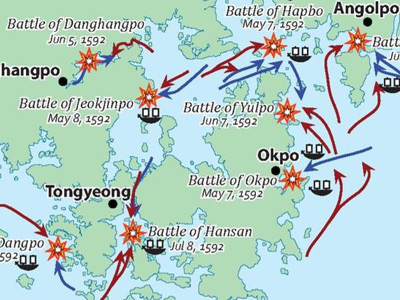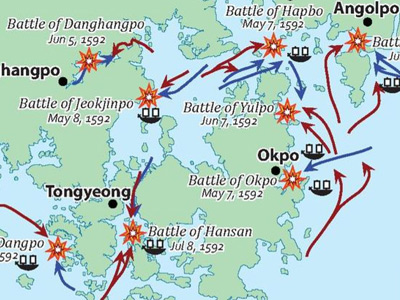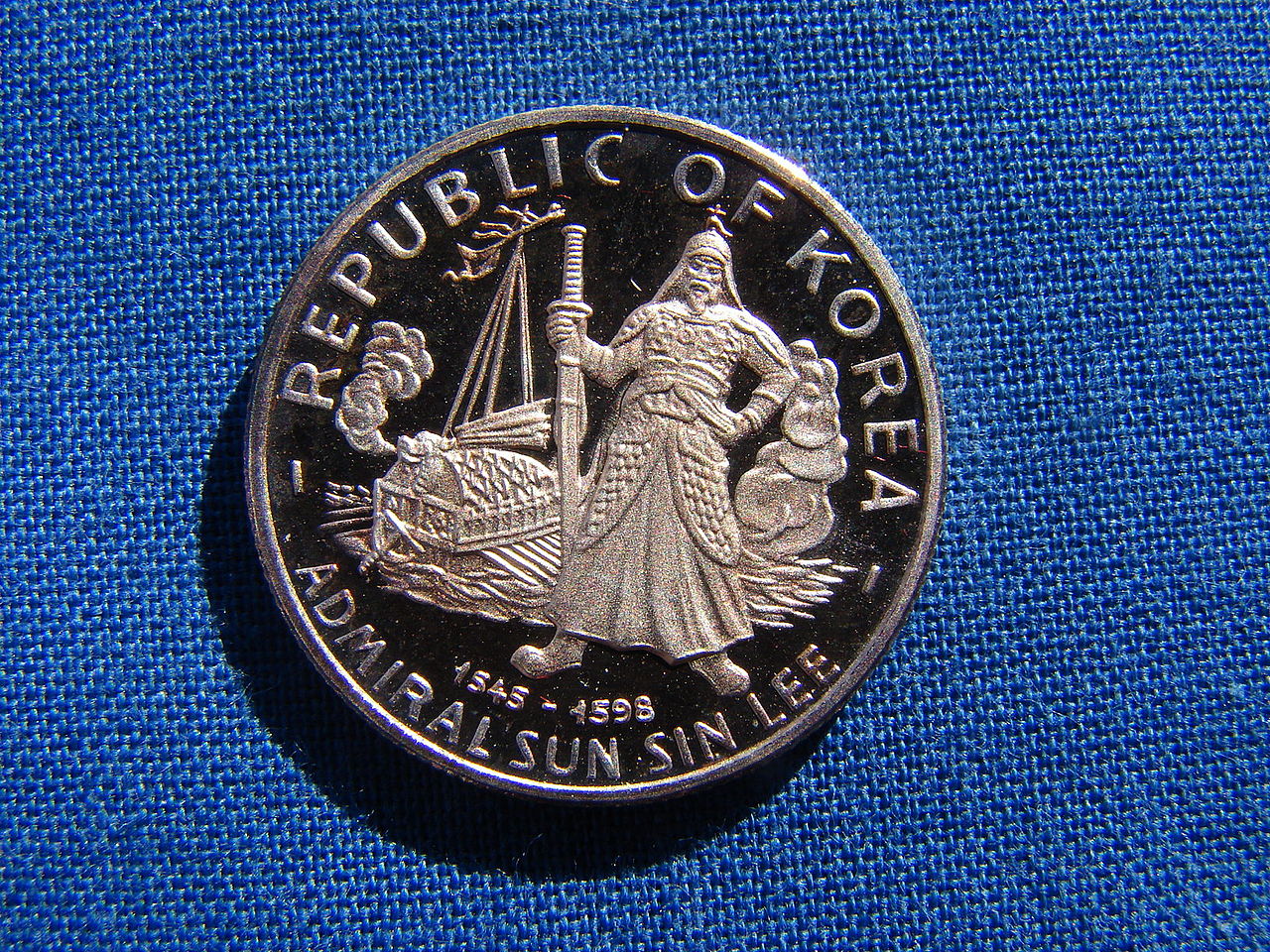Battle of Myeongnyang (1597)

Battle
Preparation
Admiral Yi studied numerous sites for his last stand with the Japanese navy and decided on luring them into the Myeongryang Strait. The Japanese would clearly enter the strait when the tide was favorable; thus, he didn't want to fight south of the strait, with the current at the attacker's advantage. Instead he wanted to fight in the waters just north of the strait, where the currents were calmer. The strait had very strong currents that flowed at approximately 10 knots, first in one direction, then in the opposite direction, in three hour intervals. Admiral Yi realized he could use this unique condition as a force multiplier. The narrowness of the strait would prevent the Joseon fleet from being flanked by the numerically superior enemy fleet, and the roughness of the currents prevented the Japanese from effectively maneuvering, forcing them to attack in smaller groups, and made it difficult to close in with the Korean ships. Furthermore, once the tide changed the flow of the current would in effect push the Japanese away from Yi's fleet and the momentum could be harnessed to increase the effectiveness of a counterattack.
First phase (north flowing current)
Early in the morning of October 26, the huge Japanese fleet was spotted by Yi's scouts as they deployed around the small bay on the southern end of Myeongnyang strait. Admiral Yi's fleet then redeployed out of their base in Usuyeong to block the northern end of the strait. Yi described about "...200 enemy ships... flowing [into the strait]" and at least 133 ships in his immediate vicinity. It is estimated that at least 133 ships were combat warships and at some 200 ships immediately behind were logistical (supply and troop carrying) support ships. In Japanese records, the ships at the front of their formations were the middle class warships called Seki-bune, as the Japanese fleets by this time understood the devastating offensive capabilities of the main Korean warships which were near the strait.
Yi's warships deployed on the northern end of the strait and dropped anchor. Yi in his flagship advanced upon the vanguard of the Japanese fleet, which was commanded by Kurushima Michifusa. For a time only the flagship fought in the battle. The crews of the Joseon fleet were made up of survivors from Chilchonryang and they were still badly shaken up and intimidated by the overwhelming size of the Japanese fleet. Yi said in his diary: "My flagship was alone facing the enemy formation. Only my ship fired cannons and arrows. None of the other ships advanced, so I could not assure our outcome. All other officers were seeking to run, as they knew this battle was against a massive force. Ship commanded by Kim Eok-chu, the Officer of Jeolla Right province, was at 1 majang (approximately 2–3 km) away." For a time it looked like Yi's flagship was "... standing like a castle in the middle of the sea."
The flagship's ability to hold out against the Japanese vanguard eventually gave heart to the rest of Yi's fleet and small groups of his ships came to his aid. First came a ship commanded by local magistrate An Wi and then several ships commanded by central squadron leader Kim Ung-ham. Seeing the success of the flagship and the handful of other boats, the rest of Yi's fleet joined in the fight.
Second phase (south flowing current)
The tide soon shifted and the Japanese ships began to drift backwards and collide with each other. In the confusion, Admiral Yi ordered his ships to advance and press the attack, ramming 30 Japanese ships. The dense formation of Japanese ships crowded in the narrow strait made a perfect target for Joseon cannon fire. The strong tides prevented those in the water from swimming to shore, and many Japanese sailors who abandoned sinking or damaged ships drowned in the currents. By the end of the battle, approximately 30 Japanese warships were sunk. Some Korean documents record the number of damaged Japanese warships, which also includes those not sunk but sustaining some amount of damage; however, the condition of the damaged ships is unclear.
The official record of Todo Takatora
The official record of Todo Takatora, who was the commander of the Japanese fleet, summarized this battle as a decisive defeat:
"御歸陣被成候 ちとまへかとにこもかいへ御こしなされ候 処にすいえんと申所にはん舟の大しやう分十三そうい申候 大川のせよりはやきしはのさし引御さ候 所の內にちとしほのやハらき申候 所に十三そうのふねい申候 それを見付是ともとり可よし舟手と御相にてはいまのせとをこきくたし候 儀はなるましきとていつれもせきふねを御かゝり被成 さき手のふねともハ敵船にあひ手負あまたいてき申候 中にも來島出雲守殿うちしににて御座候 其外ふね手の重めしつれられ候 からうのもの共もくわはん手負討死仕候 処に 毛利民部大夫殿せき舟にて、はんふねへ御かゝり成候。 はん船へ十文字のかまを御かけ候処に、 はん船より弓鉄砲はけしくうち申候に付、 船をはなれ海へ御はいりなされ、あやうく候 処に、藤堂孫八郎、藤堂勘解由両人船をよせ、敵船をおいのけ、たすけ申候。 朝の五しふんより酉の刻まて御合戰にて御座候 みなとのやうすはん船能存候に付風を能見すまし 其せと口をめけほをひきかけはしらせ申について是非なくおつかけ申儀もまかいならす いつみ樣も手を二か所おはせられ候."
This can be translated as follows:
"We came back to the camp. There were 13 Joseon ships in the sea. It is the whirlwind sea, but 13 ships stood there while it had calmed. We decided to fight with them. The width of the sea is too narrow so that we prepared Sekibune and started the battle. Starting the battle, lots of our people got wounded. And sir Kurushima Michifusa was killed. Also, lots of our people got captured. Half of my subordinates officers were wounded or killed. Mori attacked the enemy's ship riding on a Sekibune. To get aboard to the enemy's ship, we threw sickles. But the enemy shot the arrows and bullets fiercely, so he got endangered. Todo Songhachiro, Todo Kanggaiu's ships pushed the enemy's ship and saved him. We fought from morning till night. We ran out of the narrow sea hoisting a sail. Because of that fact, the enemy's ships could not chase us. Izzumi (Todo Takatora) got wounded in his arms."
HISTORY

RESOURCES
This article uses material from the Wikipedia article "Battle of Myeongnyang", which is released under the Creative Commons Attribution-Share-Alike License 3.0.
© Stories Preschool. All Rights Reserved.










